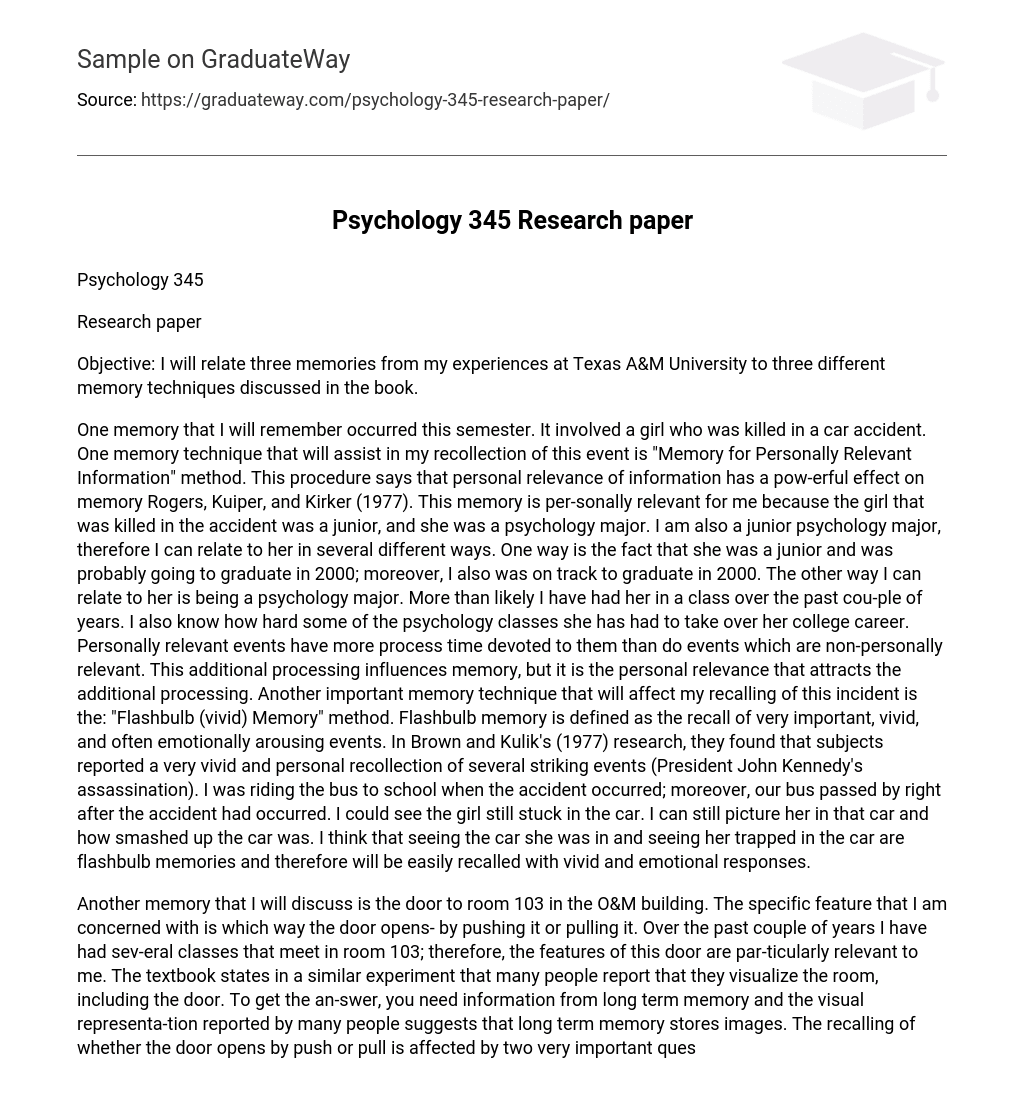Objective: I will relate three memories from my experiences at Texas A&M University to three different memory techniques discussed in the book.
One memory that I will remember occurred this semester. It involved a girl who was killed in a car accident. One memory technique that will assist in my recollection of this event is “Memory for Personally Relevant Information” method. This procedure says that personal relevance of information has a pow-erful effect on memory Rogers, Kuiper, and Kirker (1977). This memory is per-sonally relevant for me because the girl that was killed in the accident was a junior, and she was a psychology major. I am also a junior psychology major, therefore I can relate to her in several different ways. One way is the fact that she was a junior and was probably going to graduate in 2000; moreover, I also was on track to graduate in 2000. The other way I can relate to her is being a psychology major. More than likely I have had her in a class over the past cou-ple of years. I also know how hard some of the psychology classes she has had to take over her college career. Personally relevant events have more process time devoted to them than do events which are non-personally relevant. This additional processing influences memory, but it is the personal relevance that attracts the additional processing. Another important memory technique that will affect my recalling of this incident is the: “Flashbulb (vivid) Memory” method.
Flashbulb memory is defined as the recall of very important, vivid, and often emotionally arousing events. In Brown and Kulik’s (1977) research, they found that subjects reported a very vivid and personal recollection of several striking events (President John Kennedy’s assassination). I was riding the bus to school when the accident occurred; moreover, our bus passed by right after the accident had occurred. I could see the girl still stuck in the car. I can still picture her in that car and how smashed up the car was. I think that seeing the car she was in and seeing her trapped in the car are flashbulb memories and therefore will be easily recalled with vivid and emotional responses.
Another memory that I will discuss is the door to room 103 in the O&M building. The specific feature that I am concerned with is which way the door opens- by pushing it or pulling it. Over the past couple of years I have had sev-eral classes that meet in room 103; therefore, the features of this door are par-ticularly relevant to me. The textbook states in a similar experiment that many people report that they visualize the room, including the door. To get the an-swer, you need information from long term memory and the visual representa-tion reported by many people suggests that long term memory stores images. The recalling of whether the door opens by push or pull is affected by two very important questions. One issue is whether or not some representations in long term memory are functionally equivalent to visual perception (Solso, 1991). In other words, was the visual information retrieved from memory or, alternatively, was the information retrieved in nonvisual form and then converted to a subjective visual experience. The second question that is raised is the func-tional equivalence of images and visual perceptions. The research strategy to determine directly if a representation in memory is identical to a visual percep-tion is to establish conditions under which imagery theoretically should be a fac-tor and then determine if performance is comparable to what would happen if the person actually were seeing the event. Given this, arguments can be made that the image functions equivalently to visual perception.
Some memories that I will probably forget over time are who I went to sporting events with when A&M lost the game. Because A&M didn’t win, I think the personal relevance that I had in other memories mentioned would not occur in these memories. My basis for this is Rogers, Kuiper, and Kirker (1977), when they showed that personal relevance of information had a powerful effect on memory. Another factor in my memory of these people is memory and aging. Leah Light (1991) came up with four general hypothesis about age-related memory deficits: 1. Failure to use effective strategies for remembering due to insufficient knowledge about memory, 2. Defective encoding of experiences due to deficits in comprehension, 3. Deficiencies in deliberate retrieval, 4. Encoding deficits due to reduced cognitive processing capability.
Conclusion:The memory of the student dying in the car wreck will be stored as a flashbulb memory for future recollection. The fact that she and I both were junior psychology majors, and the visual picture I have of her trapped in her car will reinforce this memory, and therefore be recalled with much emotion and vividness. The memory of the door to room 103 at the O;M building will remain in my mind as a visual representation, because I have had several classes in that room. The recollection of this image in my mind is under debate because of the issue of whether or not the representation in my long-term memory is equivalent to visual perception. The other question is whether or not a representation in memory is identical to a visual perception.





